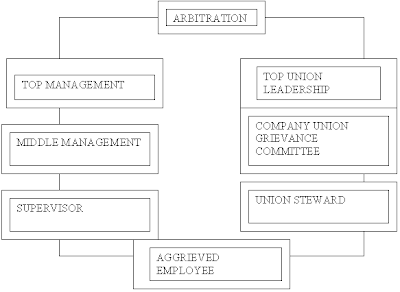Grievances always vary from company to company and it has many definitions also by many authors. Grievance is used company to indicate various forms and stages of an employee’s dissatisfaction.
According to the Dale Yoder, “a written complaint filled by an employee and claiming unfair treatment.” Another definition comes with Prof. Jucious who defines as, “any discontent or dissatisfaction, whether expressed or not and whether valid or not, arising out of anything connected with the company that an employee thinks, believes or even feels unfair, unjust or inequitable.”
There are various factors which arise Grievances. A grievance is always a symbol of some malfunctioning or maladjustment and an able and skillful manager can always find out the real or submerged reasons for a grievance.
The dispute or grievance constitutes a managerial problem and the scientific method is usually most productive in arriving at a satisfactory solution.
On the Grievance handling procedure from MBA books, MB 0027 writes:
A grievance should be dealt within the limits of the first line supervisor.
The appellate authority should be made clear to the employee so that is he cannot get satisfaction from his immediate supervisor, he should know the next step.
The grievance should be dealt with speedily.
In establishing a grievance procedure, if the grievance is against an instruction given by a superior in the interest or order and discipline, the instructions must be carried out first and then only employee can register his protest.

In the grievance handling the some factors include:
Receive and define the nature of the dissatisfaction.
Get the facts.
Analyze and divide.
Apply the answer.
Follow up.
In establishing a grievance procedure, if the grievance is against an instruction given by a superior in the interest of order and discipline, the instructions must be carried out first and then only employee can register the protest.
In the language of the labour management relations, a grievance is a complaint formally presented by the employee or employees to the management.
In case, the grievance has not been settled by top management and top union leadership, the same may be submitted to an impartial arbitrator.
According to the Dale Yoder, “a written complaint filled by an employee and claiming unfair treatment.” Another definition comes with Prof. Jucious who defines as, “any discontent or dissatisfaction, whether expressed or not and whether valid or not, arising out of anything connected with the company that an employee thinks, believes or even feels unfair, unjust or inequitable.”
There are various factors which arise Grievances. A grievance is always a symbol of some malfunctioning or maladjustment and an able and skillful manager can always find out the real or submerged reasons for a grievance.
The dispute or grievance constitutes a managerial problem and the scientific method is usually most productive in arriving at a satisfactory solution.
On the Grievance handling procedure from MBA books, MB 0027 writes:
A grievance should be dealt within the limits of the first line supervisor.
The appellate authority should be made clear to the employee so that is he cannot get satisfaction from his immediate supervisor, he should know the next step.
The grievance should be dealt with speedily.
In establishing a grievance procedure, if the grievance is against an instruction given by a superior in the interest or order and discipline, the instructions must be carried out first and then only employee can register his protest.

Grievance Handling Procedure Image
In the grievance handling the some factors include:
Receive and define the nature of the dissatisfaction.
Get the facts.
Analyze and divide.
Apply the answer.
Follow up.
In establishing a grievance procedure, if the grievance is against an instruction given by a superior in the interest of order and discipline, the instructions must be carried out first and then only employee can register the protest.
In the language of the labour management relations, a grievance is a complaint formally presented by the employee or employees to the management.
In case, the grievance has not been settled by top management and top union leadership, the same may be submitted to an impartial arbitrator.

0 comments:
Post a Comment